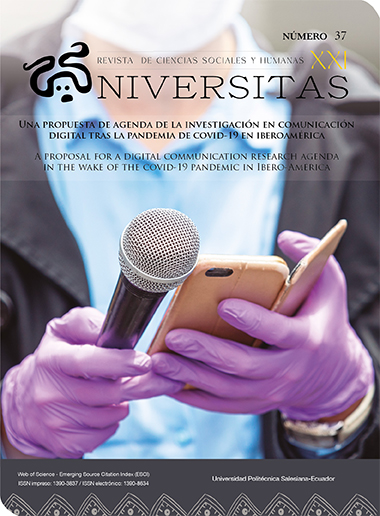¿La Covid-19 ha infectado las noticias? Cómo los periodistas, las audiencias y los procesos de producción son alterados por las pandemias
Contenido principal del artículo
Resumen
Detalles del artículo
La Revista Universitas-XX1 se alinea con los principios de acceso abierto y colaboración académica al adoptar la licencia Creative Commons Atribución-NoComercial-CompartirIgual 4.0 Internacional (CC BY-NC-SA 4.0). Esta licencia garantiza que los contenidos publicados puedan ser utilizados y compartidos ampliamente bajo las siguientes condiciones:
Atribución: Los autores y la revista deben ser reconocidos adecuadamente como los creadores del contenido original, proporcionando la referencia completa y el enlace correspondiente a la publicación.
Uso no comercial: Los contenidos no pueden ser utilizados con fines comerciales, preservando su propósito académico y educativo. Compartir igual: Las obras derivadas deben distribuirse bajo los mismos términos de esta licencia, fomentando la creación de conocimiento accesible y equitativo.
Al implementar esta licencia, la Revista Universitas-XXI refuerza su compromiso con la difusión de investigaciones de calidad, el acceso libre al conocimiento y la promoción de un entorno colaborativo entre investigadores, docentes y estudiantes de todo el mundo.
Esta decisión refleja los valores fundamentales de responsabilidad, ética y transparencia en el ámbito académico, asegurando que los aportes intelectuales sirvan como base para nuevas investigaciones y proyectos, respetando los derechos de los autores y de la comunidad científica.
Para más información sobre esta licencia, puede consultar el siguiente enlace: https://creativecommons.org/licenses/by-nc-sa/4.0/
Referencias
Survey available at https://docs.google.com/forms/d/e/1FAIpQLScMwxkD-UvSbulCX_AtKIZA-vrlj0JlkUkXEKi4sFZ5M1UhVQ/closedform. Some results were published on “Portal dos Jornalistas” (Brazil) at https://www.portaldosjornalistas.com.br/o-coronavirus-e-os-veiculos-de-comunicacao-xviii/?fbclid=IwAR3knGT6wBzgL3uB6MhFzahogZBD3ViNsgx8aM7RZah3vOxQRDcd-nSt-_k. See more details in section 5.
According to the Moral Foundations Theory, narratives may contain foundations that relate to moral choices of individuals, thereby causing engagement, such as: (1) care / harm (concern for the suffering of others); (2) fairness / cheating (preference for reciprocity and fairness); (3) loyalty / betrayal (concern for the common good and prejudice against strangers); (4) authority / subversion (reference to domination and hierarchy); (5) sanctity / degradation (concern for purity); and (6) liberty / oppression (feelings of restraint and resentment towards those who dominate and restrain their liberty) (Graham et al., 2013).
Published in:https://docs.google.com/forms/d/e/1FAIpQLScMwxkD-UvSbulCX_AtKIZA-vrlj0JlkUkXEKi4sFZ5M1UhVQ/closedform
Respectively, 121 journalists from press, 119 journalists from general media and 107 news consumers that are not journalists.
In this sense, in Portugal, the Sindicato de Jornalistas and Sindicato de Professores (Union of Journalists and Union of Teachers) have been developing a teacher-oriented training in the field of Education for Media, in several Portuguese cities. The purpose is to empower teachers to develop activities on Education for Media, following a project methodology and integrating students and other members from the school and educational communities. The trainers will be journalists and academic experts in the area of journalism who will address concepts related to media and journalism, based on analysis and discussions of international studies, connecting them to the exploration of pedagogical resources, in order to create and develop Education for Media projects, in the schools where the trainees perform their duties. In 2017, the Brazilian Ministry of Education approved the Base Nacional Comum Curricular (National Curricular Common Base), which included a critical reflection on media consumption and production in basic education, with the purpose of systematising discussions that already integrated disperse initiatives at different levels of formal and non-formal education in the country (Pegurer-Caprino; Martínez-Cerdá, 2016). In addition, several media outlets and information verifiers, such as Agência Lupa, offer teaching courses and materials that allow the public to adopt journalism verification practices in their daily lives (Paganotti, 2018). Recently, new media education initiatives started offering teaching materials through massive online courses for a broader audience, such as the “Vaza, Falsiane!” course (Paganotti et al., 2019).

